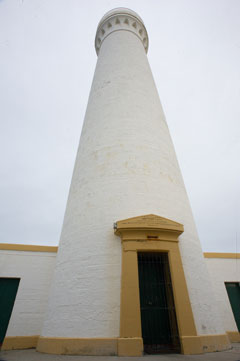| Light Established: | 1846 |
| Engineer: | Alan Stevenson |
| Position: | Latitude 57 43.5' N Longitude 03 20.2' W |
| Character of Light: | Flashing White/Red every 20 secs(now decommissioned) |
| Elevation (ASL) | 49 metres |
| Range: | White 24 Nautical Miles Red 20 Nautical Miles |
| Structure: | White tower 36 metres in height |
Covesea Skerries Lighthouse
The lighthouse here at Covesea Skerries is one of nearly 200 that are located all around Scotland’s wild coastline. Operated and maintained by the Northern Lighthouse Board they warn ships of dangerous waters and provide important navigational information.
The Sensational Stevensons
Between 1797 and 1938 Robert Stevenson and his descendants designed most of Scotland’s Lighthouses, including this dramatic building. The remote and challenging lighthouse locations underwrite an amazing historical achievement. Robert Stevenson, the architect and builder of the Lighthouse, had a facination with Egypt and instilled some Egyptian themes in many of his Lighthouses. Here at Covesea he added numerous pieces of Egyptian detail in his architecture and design flurishes and along with Ardnamurchan on the West Coast has the best examples of his handiwork.
Robert Stevenson’s talented family also included the famous writer Robert Louis Stevenson (his grandson). Visits with his father to remote lighthouses are thought to have inspired his books Kidnapped and Treasure Island.
Lighting the Moray Firth
Following the loss of 16 ships during a storm in the Moray Firth in November 1826 many applications were made for lighthouses to be established at Tarbat Ness (near Portmahomack on the Black Isle) and Covesea Skerries to mark the wide entrance to the Firth and its confusing series of inlets. Preference was given to the building of Tarbat Ness lighthouse; this magnificent tall light with its two distinguishing broad red bands was designed by Robert Stevenson and was first lit in 1830. Tarbat Ness can be seen on a clear day.
However, local demand for a light at Covesea Skerries continued and following lengthy petition approval was finally received for the building of the lighthouse on Craighead and a beacon on the dangerous Halliman's Scars. By this time Robert’s son, Alan, had joined the family business and he designed and built the new Covesea Skerries lighthouse and beacon. The iron beacon, which is a pyramid of iron pillars was completed in 1845 and the new lighthouse followed in 1846.
High walls were built around the lighthouse complex for shelter but these caused 'strong whirlwinds' in the courtyard, which interfered with the lightkeepers lookout, so in 1907 the walls were lowered. Egyptian influences can be seen in the entrance to the tower, the chimneys of the cottages and the arches at the top of the lighthouse tower beneath the balcony.
Keeping the Light on
A Principal Lightkeeper and an Assistant and their families lived at Covesea Skerries until the light became automated in 1984. Lightkeeping was a remote, lonely and hard existence. One task overruled everything: the light must burn at maximum intensity throughout the hours of darkness. During long winter nights, the need to constantly check everything and trim the lamp wicks every four hours was extremely demanding.
Keeping the Light out
Daytime, and the relentless demands of ‘lightkeeping’ continued as reflectors were polished, oil was replenished and windows cleaned in preparation for the next evening. This work had to be undertaken in partial darkness. If light from the sun hit the lens the intense heat could damage the burner and possibly ignite a fire.
French Crystal
The original lens from Covesea Skerries Lighthouse was made from a series of perfectly polished crystal glass lenses set into a brass structure. Called a Fresnel Lens, after its French creator, these intricate constructions were flat on one side and ridged on the other, like the rings of a tree. Each ring is slightly thinner than the next and focuses the light toward the centre, creating a narrow beam of light. This lens is now in the Lossiemouth Fisheries and Community Museum; it is so large that it can be seen on both the lower and upper floor.
How did the light operate?
The lighting system is decommissioned but did have an array of sealed-beam electric lamps, similar to those used by locomotives for headlights. When daylight fell and rose between set levels a small light sensor automatically switched the banks of lights on and off.
The light was monitored from the Northern Lighthouse Board's offices in Edinburgh. The light was visited on a regular basis by a local person to carry out basic maintenance and cleaning. Once a year the Northern Lighthouse Board Technicians would visit the light to carry out maintenance.



